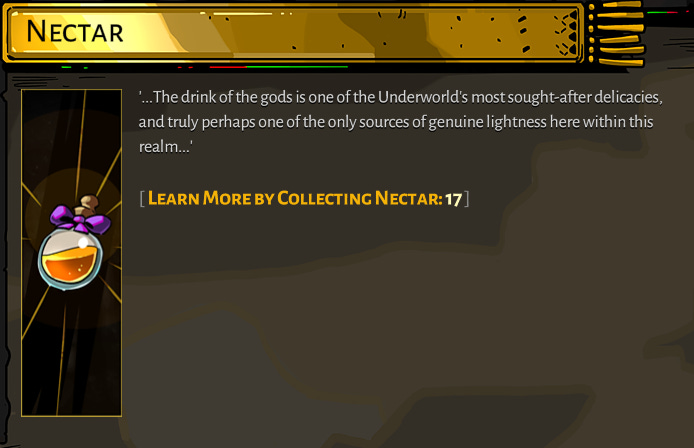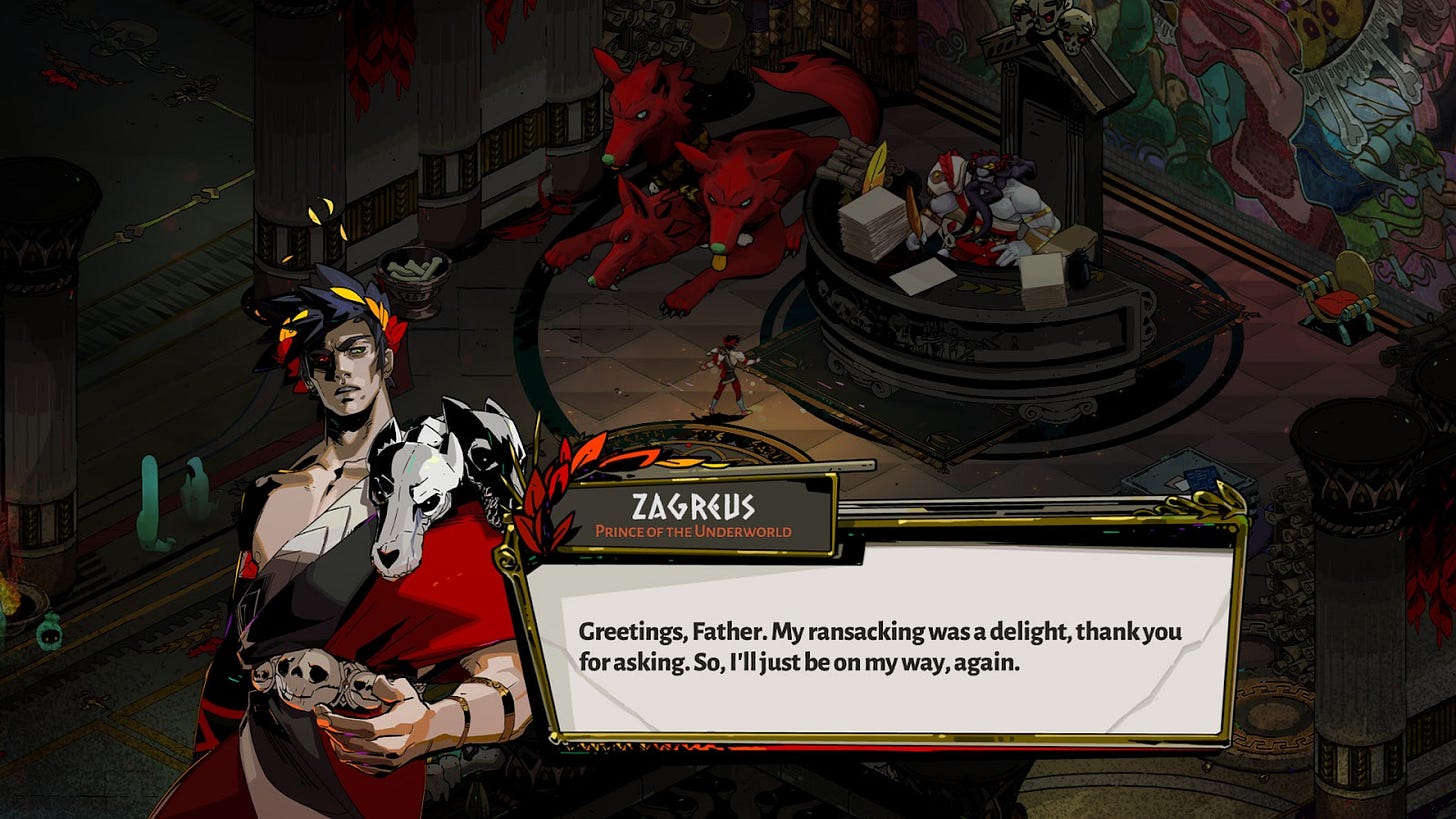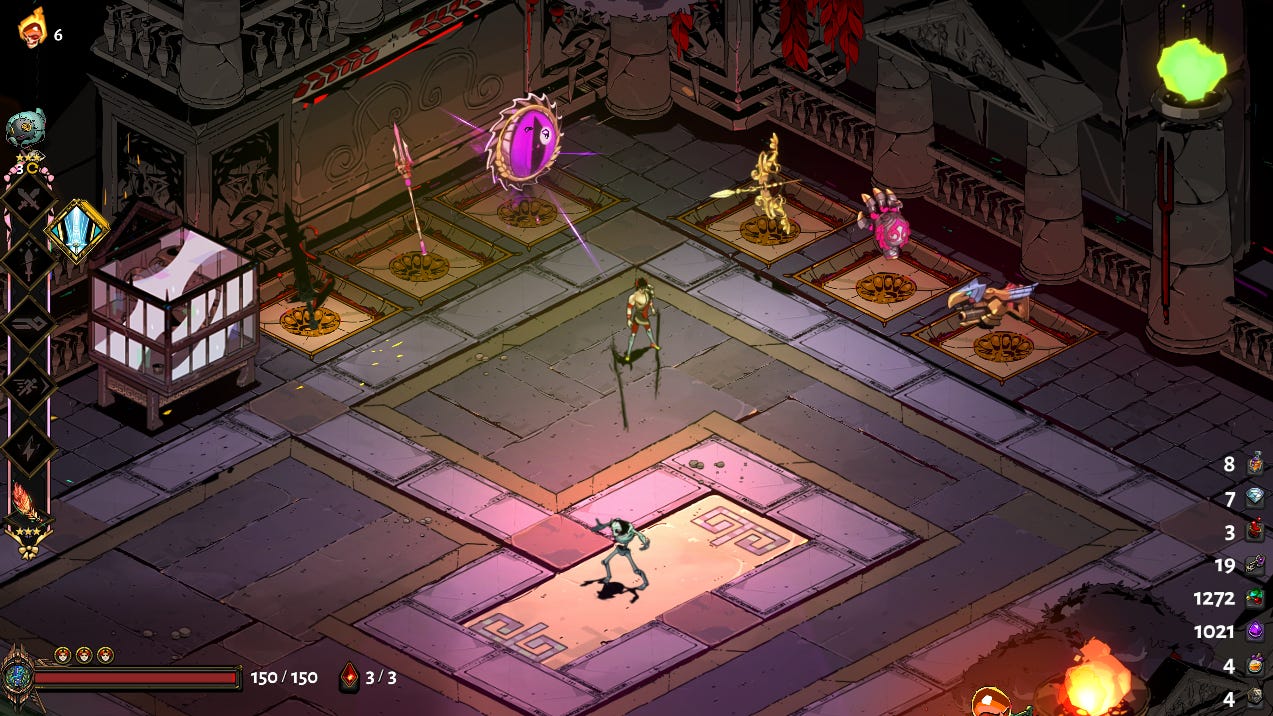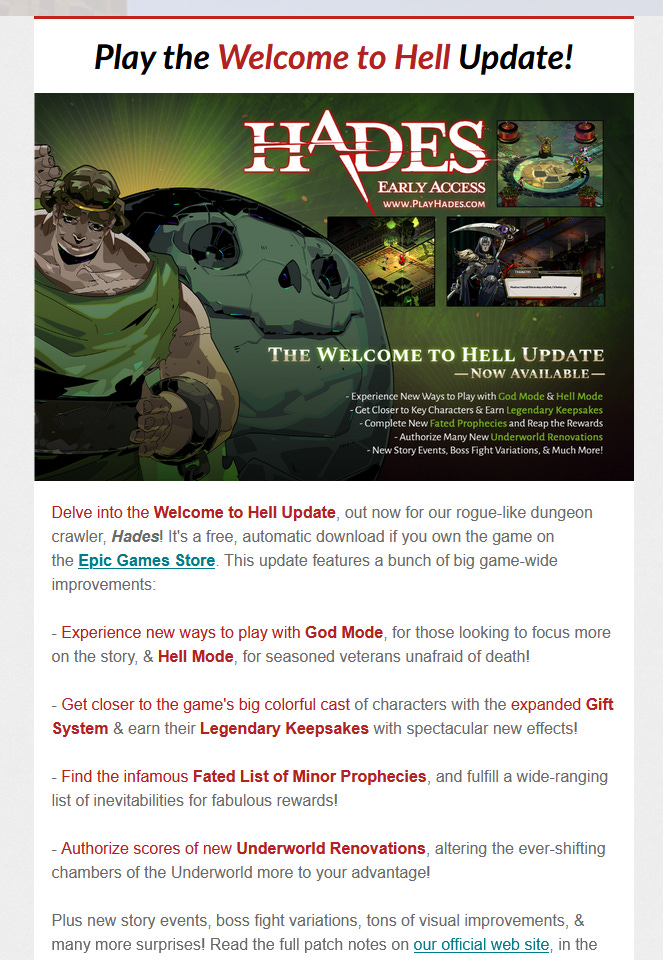Why Hades Was A Success
The biggest reason is flow
I previously wrote about two other games (Vampire Survivors and Pizza Tower) that were breakout hits from first time developers for reasons that were not exactly clear. Another game has nagged me for years that was a smash hit: Hades by Supergiant Games. It nags me because I don’t think this title has been inspected enough. The most obvious aspects like Jen Zee’s art and Darren Korb’s music are certainly part of it, but the whole work - both what it did and didn’t do well - must be examined if we are ever to learn anything here.
I played Hades while it was still going through its early access period and was witness to most of the major changes before it went into 1.0 in 2020. During early access, Supergiant Games added a substantial amount of content on every existing front. When Hades finally hit 1.0, I saw it through to the “true” ending of the game which took me an additional 10 hours to get and ultimately stepped away from the game feeling satisfied with its final state. In total I put in about 150+ hours into the game.
Now it is not true to say there has been no inspection. If there’s any video to watch for context, then let it be this one by People Make Games on Hades’ narrative system. It covers a lot of ground in just ten minutes.
Video game documentary channel Noclip also did an entire series of videos on Hades called Developing Hell (a sort of spiritual sequel to Giant Bomb’s “Building The Bastion” which was filmed by the developers and followed the production of Supergiants’ first game Bastion) that is also worthy of consideration.
Multiple GDC talks have been given by Supergiant Games staff, but these really only focused on the “popular” aspects of the game like the audio production.
Rare are the pieces that get close to what I think are the most important points, such as Nat Rowley’s “How Hades Creates A Responsive Underworld” that is focused on the game’s impressive user interface and user experience (UI & UX).
It’s a game worth studying and not just for signs and feedback but for all of the aspects that work in harmony to form a GOTY.
Unfortunately they don’t explicitly answer why the game is so successful, so I’m going to try. The short version is the following: Hades is very good at inducing flow state because every single system within it is geared towards that goal.
A Brief Explanation Of Flow
Hungarian-American psychologist Mihaly Csikszentmihalyi who passed away in October 2021 wrote a book called Flow: The Psychology of Optimal Experience. As noted in chapter 6 of Natasha Dow Schüll’s excellent Addiction By Design: “[he] popularized the term ‘flow’ to describe states of absorption in which attention is so narrowly focused on an activity that a sense of time fades, along with the troubles and concerns of day-to-day life.”
Csikszentmihalyi identified four “preconditions” of flow: first, each moment of the activity must have a little goal; second, the rules for attaining that goal must be clear; third, the activity must give immediate feedback so that one has certainty, from moment to moment, on where one stands; fourth, the tasks of the activity must be matched with operational skills, bestowing a sense of simultaneous control and challenge.
Schüll, Natasha Dow. Addiction by Design: Machine Gambling in Las Vegas (p. 166). Princeton University Press. Kindle Edition.
Let us also recall the background to the famous “30 seconds of fun” that was attributed to Jaime Griesemer regarding the Halo franchise.
"[But] the worst part is, everyone uses [30 seconds of fun] to mean exactly the opposite of what I meant when I said it! They use it to say you only need 30 seconds of fun, and if you repeat something that is fun for 30 seconds over and over you have a game like Halo. There was a whole second half of the quote that got cut out of the [video documentary] where I talked about taking that 30 seconds of fun and playing it in different environments, with different weapons, different vehicles, against different enemies, against different combinations of enemies, sometimes against enemies that are fighting each other. No 30 second stretch of Halo is ever repeated; the missions are constantly changing the context on you."
Keep both of these quotes in mind as we return to Hades.
Loops Within Loops
Prior to learning about flow, I understood the so-called state of absorption as “loops”, so I’ll be using that term throughout this piece. Hades contains numerous loops that intertwine. These loops take different forms and are attached to different things in the game, but broadly speaking they fall under three categories:
Story loops
Gameplay/mechanical or “knowledge” loops
Meta-progression loops
From watching the PMG video earlier, you’ll be familiar with how the game triggers different dialog events of the story depending on whatever condition the player is or was in. What’s not underlined is the game pushes you towards all these story loops as a result of the other loops, and those story loops in turn push you back towards the gameplay and progression loops.
Let’s take an example: the first time you go on a run in Hades you are met with a boon from one of the gods of Olympus (sidenote: the available pool of gods on that very first run is deliberately limited to just a handful and this is leveraged by speedrunners). Each time you activate a boon you are rewarded with three things:
A one-way piece of dialog from the god (your “story” reward)
A mechanical buff to your current abilities (the “boon” itself)
Either a visible or semi-hidden increment towards another loop (furthering the game’s meta progression)
The dialog is very unlikely to repeat given how the game keeps track of player state and the sheer amount of text available. Subsequent dialog with that exact god even during the same run will potentially comment on what you have equipped, what progress you have made, or even what other god boons you have taken just before them.
The mechanical buffs are more limited and are highly repetitive, but that’s the entire point of them since the player sets out with a goal of making a viable end-game “build”. Too much potential choice in these boons would risk watering things down and affecting player agency. Simultaneously, each of the god boons act as a sort of miniature skill tree.
Upon activating a boon the player gets to choose one of three effects to their character that can have a significant effect to their overall run’s build:
These effects can stack not only with other god boons, but also with other mechanical systems in the game. The most obvious of these are things like the Daedalus hammer that will positively change the attack properties of your equipped weapon for that run, or specific permanent upgrades you get from spending the meta-progression currency like increased damage against enemies afflicted with multiple status debuffs.
There’s three things to add about interactions with god boons. The first is that the player character in the shoes of Zagreus can give gifts of nectar to the gods to increment a relationship meter with them and get an immediate reward in the form of a trinket to wear for their next run (this relationship system also gates the true ending of the game).
The second is that the game has its own internal achievements system called “The Fated List” that, as well as giving the player a host of tasks to perform, rewards you materially for collecting all the boons from the pantheon.
The third is the in-game codex slowly unlocks various story details the more times you interact with a particular god, one line at a time.
All three things - the gifting, the list of achievements, the codex - aren’t initially offered up to you, however, which is highly important. Hades doesn’t overload the player with all this information right from the start. It simply presents itself as an ancient Greek themed action slasher that, to partly misquote a coworker, “doesn’t need to explain itself”. You play as an angsty young adult trying to escape hell, who is also your father - no further details needed.
Consistency Within A Run
Hades is a “roguelike” game. Roguelike should not be considered the same as random, because Hades is extremely consistent in several ways. With the slim exception of starting a fresh run or a particular modifier, you almost always know before going into a chamber what your reward is going to be, since it’s marked on the door. When you first start, you might not know what some of these symbols represent:
Yet through play you learn what they mean. When chambers quickly start to offer more than one exit, the knowledgeable player will already have an idea of what they want to target, because by that point they will have already run through the game enough times to learn what to go after. If they’re trying to get further into a run, they’ll likely target health, gold or damage upgrades. Players trying to improve their chances on later runs might instead aim for meta-progression currencies.
The one aspect I find the most fascinating is just how long a player spends in each chamber of a Hades run. During the early access period I occasionally put a timer on my phone to test how long it took to clear out any chamber at any point of a run (be it the first or the forty-first) and it usually took somewhere between 15-30 seconds. This wasn’t an attempt at speedrunning; I just wanted to see how much time was spent in each combat encounter.
Chamber duration is important because another facet of Hades’ appeal is its save system. At any point you can quit the game and return to your run later, so if you literally only have time for a couple of minutes of play, then you can absolutely knock out a chamber or two. The ease at which people of any background can come and go from Hades reduces player friction and thus enjoy the flow of play as quickly as their device will allow.
Assuming a player goes through an entire run to completion, they will pass through four themed areas of the underworld. In the first three the player will always hit a boss at reaching the 14th chamber, the 24th and the 36th. The final area is the most volatile one possible that can almost double the total chamber count the player needs to progress through before triggering entry to the last boss.
Over time this consistency of the first three bosses is important for the same reason god boon choice is important. As the player you are able to check what chamber you are on at any time and thus know how close you are to each boss. This means you’ll frequently end up in situations like debating whether you should spend or bank the gold you’ve accumulated so far, since it doesn’t carry over between runs. Hades underscores this by frequently presenting you with a pre-boss merchant in the form of the Stygian boatman Charon.
Though these shop items will be randomized, they will usually offer a choice of one of three things: a health pickup, a meta–progression currency, or a god boon. Two of these explicitly help you with the current run, the other will help you with future runs.
Over and over, despite the story’s stated futility of attempting to escape hell and the characters chiding you for it, the game mechanically pushes you towards that escape, giving you multiple opportunities and chances to get over the difficulty.
A Note On “Knowledge” Loops
Throughout Hades you’ll encounter the same enemy types, the same hazards, and the same bosses. All of them are another set of loops to pay attention to and, where needed, exploit.
Chambers with combat encounters account for the majority of the gameplay and typically contain various environmental props that at first glance look like set dressing. By virtue of the game’s repetitive run-based nature and the hack and slash genre, players can and will learn to use tactics such as setting off bombs near a group of enemies, or destroying a pillar to do a chunk of area of effect damage all around it (the first boss is an example of this). The same goes for learning the attack patterns of each boss. With the exception of the optional endgame “heat” mechanic (which further expands on all these knowledge loops), all the combat locations are drawn from a pool of authored arenas. All attacks in them are telegraphed. The player’s goal here with these combat loops is to pay attention to their surroundings and learn those small, moment-to-moment patterns that happen during a single chamber, which might not last longer than 30 seconds. Even if you fail in Hades, you will be told exactly what caused it.
In case you were wondering whether any of this fed into other loops: of course they do. Beat enough enemies to get more codex lore about them. Beat all enemies of a certain type and get a material reward from the Fated List to upgrade Zagreus. Then go back and do it all over again, because when you check in on your codex, or how much meta-progression currency you earned, you’ll see that you were that close to getting another thing.
Failure Is Just Another Excuse For More Loops
You will inevitably die in Hades. Dying during a run dumps you back at Zagreus’ home - the House of Hades. This is, in terms of the story, the place that Zagreus is trying to break out of and usually gets mocked for doing so by the other residents of the house via short dialog exchanges.
Mechanically this serves as a place for some downtime to reflect on what the player’s next goal should be, as well as a place to spend the meta-progression currencies, or furthering the relationship meters with other members of the house. Early on the game won’t fold these mechanics in immediately, but instead starts the player off gently with something simple: character progression.
Frequently during each run out of hell, the player will pick up a “darkness” currency that persists across all runs and functions a bit like experience points. Darkness can be spent on permanent upgrades to Zagreus’ abilities, or exchanged in bulk with a merchant for keys. Keys are spent primarily on unlocking more of Zagreus’ upgrades back at the house, or on unlocking new weapons for Zagreus’ arsenal or exchanged in bulk with a merchant for another currency one tier higher. Oftentimes the player will be able to acquire any of these currency items during a run… or buy them directly from the house merchant, sometimes at a bargain, once per downtime.
New abilities like an increase to damage or health mean a better chance at surviving a run. New weapons mix up the gameplay. Even if the player falls short in a run, they will have still picked up something towards their next goal or incremented towards unlocking something new back at the house - even if they literally fail at the first chamber of a Hades run. To further this nudging, Hades rewards you for trying other weapons for a run.
In the above image, Zagreus is in the weapon loadout room prior to setting off on another run. Zagreus has the sword selected, but the shield is glowing purple. This glow is a once-per-run buff that will give the player a +20% bonus to darkness acquired during that run for taking the shield instead. The bonus is rerolled onto another weapon after that next run ends.
Recall again what Griesemer said about taking those 30 seconds of fun and reframing them in different ways, over and over. Hades does this in spades.
Bonus Loops: Updates & Community Feedback
This section no longer applies since the game is now in 1.0 but throughout the early access period, Hades went through several major updates. These were signaled in advance not just within the game’s main menu countdown timer but externally via email campaigns. Look at the cadence of the dates below.
Almost every month, newsletter subscribers would be frequently reminded of the progress of Hades’ development. Sadly I don’t know the exact numbers of these campaigns, but I know I enjoyed receiving them and I took many notes for my own work. I encourage any aspiring copywriters to go through the archive hosted here.
Supergiant also went to the trouble of not only emailing everyone that signed up to their mailing list, but also going to the trouble of getting their in-game narrator to do dramatic readings of the patch notes. The amount of time and effort required to perform a recording session of patch notes is not something a lot of studios should consider doing; Supergiant Games is capable of pulling it off in large part because their main voice actor Logan Cunningham is so well regarded especially because he has appeared in every previous title from the studio.
Notice also in that video the little “Change inspired by community feedback” marker. Hades had a robust in-game bug feedback tool where hitting F10 on the keyboard at any time opened up a report window for players to fill out if they encountered some kind of bug. Supergiant Games also had a dedicated feedback channel on their discord server (which was inspired by a similar channel in the Rocket League discord) where users could leave comments on the game’s early access state. Other users could upvote these comments and the staff would routinely read through all of their community’s suggestions, particularly those that received a lot of votes. Occasionally, Supergiant staff would schedule AMAs on the server too, answering a selection of questions that month. Unfortunately the AMA and suggestions channels for Hades have since been archived away, but as of time of writing you can currently see a repeat of the F10 tool and community-sourced feedback for Hades II, which is currently going through its early access period.
Where Hades Falls Short
Taken piecemeal, each part of Hades is flawed, particularly the combat. I don’t enjoy the combat encounters in the game and I definitely dislike Hades’ use of input buffering. Input buffering in this sense is how the game reads the player’s inputs. In Hades’ case, it will always prioritize finishing a weapon’s sole combo attack rather than start a new string of moves unless the player significantly delays their next attack input. Though skillful play is possible, the ceiling for it is very low. It is not, and will never be something that rivals character action games like Devil May Cry or Bayonetta.
While I think it’s neat that Hades is arguably contributing to the oral tradition and retelling bits of Greek mythology in a video game of all mediums, I don’t think its story is a particularly exciting tale. I’m also at that age where I find grinding for resources to advance progression in any game to be tedious. Fortunately for Hades, the game has put an incredible amount of effort into all of its components that it’s never relying on just one of those features, because all of its features are working in tandem. The characters can feel one-note but thanks to the wealth of dialog available and the ensemble cast they won’t come across as such. The grind does not feel like one because the next goal is always in sight and the game always tells you how to get it.
It’s possible one could do an extremely deep dive into how the game keeps all its systems in check by examining the lua files that are exposed to anyone with a copy and Notepad, but that would balloon the word count of this post.
From my own experience, I always got the sense that Hades was constantly trying to push me up a fairly even curve on all fronts. Or, inverting the idea, I don’t ever recall myself maxing out a particular thing like a character’s storyline early and the game forgetting about it.
Instead, it always felt like all aspects of the game: its cast of characters, its weapons, its upgrades, its art, its music, its loops, its everything - all got evenly distributed over those 100+ hours of play. This is not an accident. It is the result of a staggering amount of work on every front by a team of people operating at the top of their craft to weave every element into one monumental endeavor. Pulling on any single thread of Hades inevitably drags the rest of the game into focus. Playing any single part of Hades even for just a minute entices you into its flow.
Fitting then that the final theme of Hades repeats the lyric of “It’s in the blood”.
Hades is by Supergiant Games and is available everywhere
















